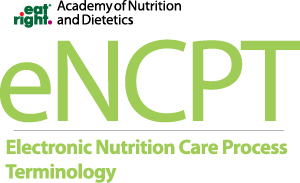The Academy continues to work toward including the concepts from the Nutrition Care Process and Terminology (NCPT) in electronic health records (EHRs) in two important ways:
- Development of messaging standards for electronic health records
- Incorporation of NCPT into standardized terminologies and terminology systems
Resources from the Academy can help develop and maintain use of the NCP and Terminology in electronic health records.
Standardized Medical Terminologies
The Academy continues working with Health Level Seven International (HL7) Electronic Health Record Workgroup to develop a specific Electronic Nutrition Care Process Record System (ENCPRS)-Functional Profile that identifies the functions of dietetics and nutrition practice that should be contained in an EHR system. The ENCPRS-Functional Profile was created to align with the HL7 International EHR System Functional Model (EHR-S FM) that provides a standard description and common understanding of functions for health care settings. To date, HL7 has developed or is developing profiles for areas such as child health, emergency care, long-term care, behavioral health, and vital statistic reporting. The ENCPRS-Functional Profile was successfully balloted at HL7 in January 2011, revised and re-approved in September 2018. The ENCPRS is now officially designated a Standard for Trial Use (STU), in the universal realm (international reach), a testing phase, with plans for balloting at HL7 as a Normative Standard. The Academy has also funded the C-CDA R2.1 Nutrition Transitions of Care Implementation Guide, an HL7 standard that identifies what nutrition data should be included in an EHR in any Transitions of Care setting. Transitions of Care settings include Home Health Agencies, Inpatient Rehabilitation Facilities, Long-Term Care Hospitals, and Skilled Nursing Facilities.
Concurrently, work is underway to include the NCPT concepts in other standardized terminologies for use in the U.S. and internationally, the Systematized Nomenclature of Medicine Clinical Terms (SNOMED CT) and Logical Observation Identifiers Names and Codes (LOINC). Per Federal U.S. Health and Human Services mandate, clinical terminologies in Electronic Health Records (EHRs) must be in SNOMED and LOINC. Nearly all of the Nutrition Diagnosis and Nutrition Intervention terms have been mapped, modeled, and accepted in SNOMED-CT. Additional work is ongoing to icomplete submission of NCPT in SNOMED-CT and LOINC.
Additionally, inclusion of the NCPT within SNOMED CT and LOINC is beneficial for promoting the use of a standardized dietetics and nutrition practice terminology throughout the U.S. and internationally, leading to improved standardization of nutrition care and outcomes reporting.
An eNCPT organization subscription provides permission and access to the NCP Terminology for use in an organization’s EHR. eNCPT organization and developer subscriptions include a downloadable spreadsheet that contains NCPT, SNOMED, and LOINC mappings.
The Academy is collaborating with SNOMED International for restructuring of the nutrition sub-hierarchies and inclusion of NCPT.
SNOMED and LOINC strive to include only one concept in each term and do not offer general “other” terms for additional items to be documented. Therefore, some concepts such as modified diets required separation (e.g., a list of categories of modified diets) into specific terms. Not all terms will be used by every nutrition and dietetics practitioner, but the NCPT lists all terms for the profession.
Nutrition Care Process Content Use in Software for Electronic Health Records
The Academy's Electronic Health Record (EHR) Toolkit is a reference tool for use by nutrition and dietetics practitioners as they and their institutions work to integrate the Nutrition Care Process and Terminology into EHRs. This collection of resources provides tailored assistance depending upon a practitioner’s responsibility or point in the process of conversion from paper to EHRs. The toolkit includes a resource for several practitioners in one or more facilities to note the terms they use most, training examples and sample forms for documenting workflow requirements, and data elements required for system configuration. This specialized resource is provided to all eNCPT subscribers. The EHR toolkit version 2.0 was released in December 2018.
Licensing
Licensing (or permission) is required to utilize the NCPT in software, either for internal use or for sale of a product. If you are a hospital or health care provider and you want to build software that utilizes the NCPT, as an interface terminology, technical information is provided with the purchase of a multi-user subscription. Software vendors are required to purchase their license via a developer subscription to the eNCPT.
The technical components provided are as follows:
- NCPT with 15-character abbreviations for each term and descriptor.
- IT professionals use this data to incorporate the terminology into the computer programming or software.
- The Academy Unique Identifier (ANDUID), a five-digit number.
- The ANDUID is used by IT professionals for data monitoring and tracking in electronic health records (EHRs).
- Food and nutrition professionals can use this number to request data needed for reports and quality improvement.
- External mappings of the NCPT to SNOMED-CT and LOINC, standardized medical terminologies in use in the U.S. in EHRs.
For more information regarding NCPT content use and the cost of an organization or developer subscription, please visit the pricing page or Contact us.
